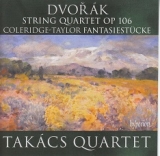Das Takacs Quartet hat vor fünf Jahren bereits das benachbarte Quartett op. 105 sowie ein Quintett von Dvorak eingespielt. Jetzt steht op. 106 im Mittelpunkt. Eine Aufwertung erfährt die CD durch die begleitenden Werke. Als Einzelsatz, ebenfalls von Dvorak, spielen sie das Andante appassionato, das der Komponist als langsamen Satz für das Quartett op. 12 komponiert hatte und später durch ein Adagio ersetzte.
Besonders interessant sind die fünf Fantasiestücke von Samuel Coleridge-Taylor. Noch in seiner Studienzeit entstanden, sind sie seinem Lehrer Stanford gewidmet und beziehen sich im Titel, weniger in der Musik, auf Schumann. Uneinheitlich im Niveau, überzeugen der am Ende stehende Tanz und die an zweiter Stelle zu hörende Serenade am meisten. Einen Bezug zu Dvorak ergibt sich bei dem dritten Stück, Humoresque, das den Titel mit Werken von Dvorak gemein hat und auch musikalisch an das Scherzo des G-Dur Quartetts andockt.
Gegenüber der bei der vorherigen Dvorak-Einspielung als zu wenig sensibel empfundenen und nicht sehr ansprechenden Spielweise hat sich diese jetzt positiv entwickelt. Doch erreicht das Ensemble damit noch nicht das Niveau, das ein Hörer sich erhoffen würde. Unverändert zeigt sich das Quartett mit seiner lebensbejahenden Art und Weise seines Spiels und der von intensivem Herangehen gekennzeichneten Interpretationspraxis.
Five years ago the Takacs Quartet already recorded the neighboring quartet op. 105 as well as a quintet by Dvorak. Now op. 106 takes center stage. The CD is enhanced by the accompanying works. As a single movement, also by Dvorak, they play the ‘Andante appassionato’ that the composer had composed as a slow movement for the quartet op. 12 and later replaced with an Adagio.
Of particular interest are the five fantasy pieces by Samuel Coleridge-Taylor. Written while he was still a student, they are dedicated to his teacher Stanford and refer to Schumann in the title, less so in the music. Inconsistent in level, the dance at the end and the serenade heard in second place are the most convincing. A reference to Dvorak comes in the third piece, Humoresque, which has the title in common with works by Dvorak and also musically docks with the Scherzo of the G major Quartet.
Compared to the playing style of the previous Dvorak recording, which was felt to be insufficiently sensitive and not very appealing, this one has now developed positively. However, the ensemble still does not reach the level that a listener would hope for. The quartet shows itself unchanged with its life-affirming way of playing and the interpretation practice characterized by an intensive approach.
























